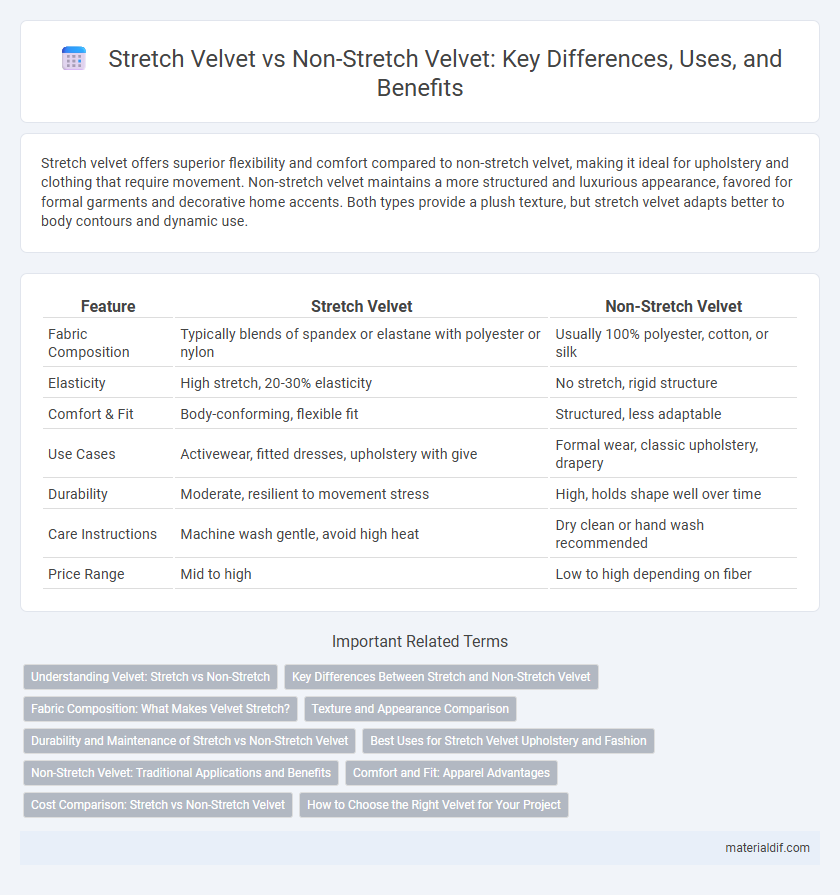Stretch velvet offers superior flexibility and comfort compared to non-stretch velvet, making it ideal for upholstery and clothing that require movement. Non-stretch velvet maintains a more structured and luxurious appearance, favored for formal garments and decorative home accents. Both types provide a plush texture, but stretch velvet adapts better to body contours and dynamic use.
Table of Comparison
| Feature | Stretch Velvet | Non-Stretch Velvet |
|---|---|---|
| Fabric Composition | Typically blends of spandex or elastane with polyester or nylon | Usually 100% polyester, cotton, or silk |
| Elasticity | High stretch, 20-30% elasticity | No stretch, rigid structure |
| Comfort & Fit | Body-conforming, flexible fit | Structured, less adaptable |
| Use Cases | Activewear, fitted dresses, upholstery with give | Formal wear, classic upholstery, drapery |
| Durability | Moderate, resilient to movement stress | High, holds shape well over time |
| Care Instructions | Machine wash gentle, avoid high heat | Dry clean or hand wash recommended |
| Price Range | Mid to high | Low to high depending on fiber |
Understanding Velvet: Stretch vs Non-Stretch
Stretch velvet combines the luxurious softness of traditional velvet with added elasticity due to spandex or elastane fibers, providing enhanced comfort and flexibility ideal for form-fitting garments. Non-stretch velvet, typically woven from cotton, silk, or synthetic fibers without elastic elements, offers a more structured drape suited for upholstery and classic clothing styles. Recognizing the fiber composition and stretchability helps in choosing the right velvet type for specific design needs and intended wearability.
Key Differences Between Stretch and Non-Stretch Velvet
Stretch velvet contains elastic fibers like spandex, allowing greater flexibility and comfort, ideal for fitted garments and activewear. Non-stretch velvet lacks elasticity, offering a more structured and traditional feel, commonly used for formal wear and upholstery. The key differences hinge on fabric composition, flexibility, and suitable applications.
Fabric Composition: What Makes Velvet Stretch?
Stretch velvet contains a blend of spandex or elastane fibers integrated with traditional velvet materials like cotton, polyester, or nylon, allowing it to expand and return to its original shape. Non-stretch velvet is typically made from 100% natural fibers such as silk or cotton or synthetic fibers without elastic components, resulting in a fabric with minimal give and less flexibility. The inclusion of elastic fibers in stretch velvet enhances comfort, fit, and movement, making it preferred for garments requiring flexibility.
Texture and Appearance Comparison
Stretch velvet features a smooth, plush texture with a slight elasticity that enhances comfort and fit, making it ideal for form-fitting garments. Non-stretch velvet offers a richer, denser pile that provides a more structured appearance and luxurious feel, often preferred for upholstery and formal wear. The subtle sheen of stretch velvet adapts with movement, while non-stretch velvet maintains a consistent, opulent luster.
Durability and Maintenance of Stretch vs Non-Stretch Velvet
Stretch velvet, composed of synthetic fibers like spandex blended with traditional velvet materials, offers enhanced flexibility and resistance to wear, making it more durable under frequent movement and stretching. Non-stretch velvet, typically made from cotton or silk, tends to be more delicate and prone to crushing and wear, requiring careful maintenance such as gentle cleaning and avoiding heavy friction. Maintenance of stretch velvet is generally easier, as it withstands machine washing and retains shape better, while non-stretch velvet often requires dry cleaning and special care to preserve its texture and appearance.
Best Uses for Stretch Velvet Upholstery and Fashion
Stretch velvet offers superior flexibility and comfort compared to non-stretch velvet, making it ideal for upholstery applications requiring durability and ease of movement, such as sofas and chairs with curved designs. In fashion, stretch velvet enhances fit and silhouette, perfect for form-fitting garments like dresses, leggings, and blazers that benefit from both softness and elasticity. Non-stretch velvet, while luxurious, is better suited for structured upholstery pieces or classic tailored clothing where rigidity and a traditional look are preferred.
Non-Stretch Velvet: Traditional Applications and Benefits
Non-stretch velvet, known for its luxurious texture and rich appearance, is commonly used in upholstery, drapery, and evening wear where structure and form retention are essential. This type of velvet offers exceptional durability and a classic, opulent look, making it ideal for high-traffic furniture and elegant home decor. Unlike stretch velvet, it maintains consistent fabric tension, ensuring a smooth, wrinkle-free finish that enhances traditional design aesthetics.
Comfort and Fit: Apparel Advantages
Stretch velvet offers superior comfort and enhanced fit due to its elasticity, allowing garments to move with the body without restriction. Non-stretch velvet, while luxurious and rich in texture, tends to have limited flexibility, resulting in a more structured and less forgiving fit. Apparel made from stretch velvet is ideal for form-fitting designs that require both softness and ease of movement, making it a preferred choice for active wear and contoured fashion pieces.
Cost Comparison: Stretch vs Non-Stretch Velvet
Stretch velvet typically costs more than non-stretch velvet due to the added elasticity fibers like spandex or lycra, which enhance comfort and fit. Non-stretch velvet is generally less expensive because it consists primarily of traditional materials such as cotton, silk, or polyester without elastic blends. When budgeting for upholstery or apparel, factoring in the price difference between stretch velvet, often priced 20-30% higher, and non-stretch velvet can influence material choice based on function and cost-efficiency.
How to Choose the Right Velvet for Your Project
Choosing the right velvet depends on the project's requirements for flexibility and comfort. Stretch velvet offers superior elasticity and softness, making it ideal for garments that require movement, such as dresses and activewear. Non-stretch velvet provides a more structured, luxurious appearance, perfect for upholstery, drapes, and formal wear where firmness and durability are key.
Stretch velvet vs non-stretch velvet Infographic

 materialdif.com
materialdif.com